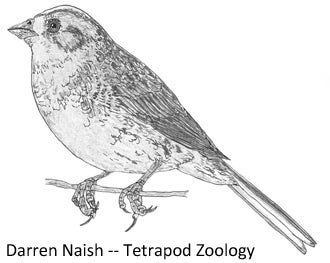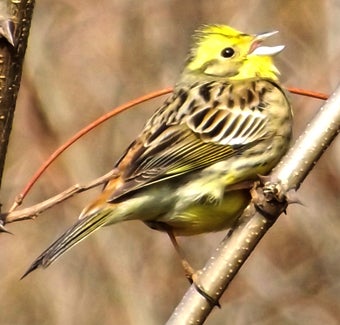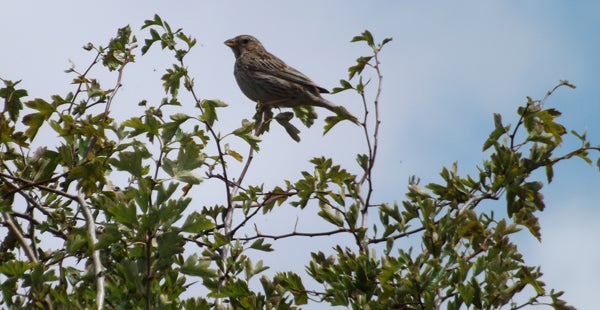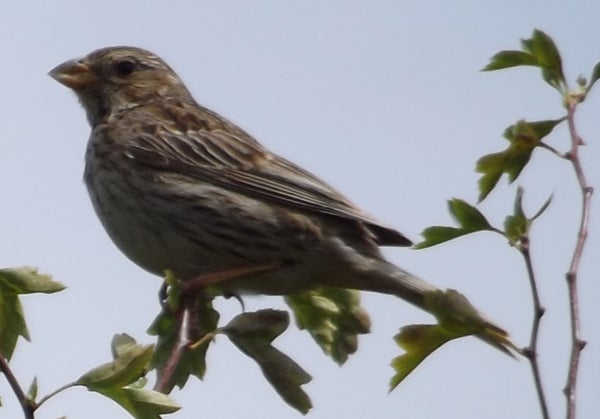This article was published in Scientific American’s former blog network and reflects the views of the author, not necessarily those of Scientific American
I’ve surely lamented on a few occasions now the sorry lack of passerine-themed articles here at Tet Zoo. For a group that constitutes over 60% of extant bird diversity, it surely doesn’t feel that they’ve received due coverage here. Anyway, here’s a short article on a group of passerines I haven’t covered before. And see the links to previous passerine-themed Tet Zoo articles below.

A generic Emberiza bunting (as illustrated for The Big Book -- on which please go here). Typical traits for the group: pointed but robust bill, stripes or other facial markings, streaked plumage on the back and wings, largely unpatterned breast and belly, long tail. Credit: Darren Naish
Today I want to talk about buntings: specifically, the ‘typical buntings’ or Old World buntings of the genus Emberiza. This is a big group, containing around 40 species which occur across Eurasia and Africa. I’ve written about them once before, since I saw (and photographed, badly) members of the House bunting E. striolata complex in the Nafusa Mountains of Libya back in 2009 (go here for that article).
On supporting science journalism
If you're enjoying this article, consider supporting our award-winning journalism by subscribing. By purchasing a subscription you are helping to ensure the future of impactful stories about the discoveries and ideas shaping our world today.
Buntings are finch-like, stout-billed passerines that typically have a streaked plumage on the back and wings and a non-patterned breast and belly; males are typically more boldly marked and brightly coloured than females. The term ‘bunting’ has actually been used for passerines that now belong to several groups. Here I’m avoiding any New World birds given that name and looking only at the Old World buntings, or emberizids. If you’re wondering, the word ‘bunting’ seemingly originated from a word meaning ‘plump’ or ‘stocky’… though the idea that this use of the term derived from the bird, rather than the other way round, has also been suggested (Greenoak 1997).

A male Yellowhammer - photographed across some reasonable distance - in Romania. Credit: Darren Naish
Anyway, among the more striking are the Black-headed bunting E. melanocephala of south-eastern Europe and western Asia (it winters in India) – it’s mostly yellow and with a prominent black hood – and the often strikingly yellow Yellowhammer E. citrinella. Yellowhammers are associated with farmland, meadows and open woodlands and are one of those birds with a famously transcribable song; it commonly being interpreted as ‘little bit o’ bread and no cheeeeese’. The ‘hammer’ part of its name, by the way, might refer to the Anglo-Saxon term ‘amore’, meaning yellow, in which case ‘yellowhammer’ involves some redundancy (Greenoak 1997).

Corn bunting observed at reasonably close distance in Berkshire, England. I don’t know how obvious it is, but the bird looks reasonably large even at this range (I mean, for a smallish passerine). Credit: Darren Naish

Close-up of the same bird. Oh, resolution not so great. Credit: Darren Naish
The other species I want to talk about is the Corn bunting E. calandra, an unusually large (16-19 cm long) bunting that’s present across Europe (except the far north), some of northern Africa and western Asia. It has declined significantly since the 1960s, this seeming to be mostly due to changes in cereal farming, mostly a decline in the use of barley. Its call is often likened to a jangling set of keys. The Corn bunting’s bill is proportionally massive relative to that of other buntings (as is its entire head) and it’s also unusual in that the sexes are alike in plumage, only differing externally in size. Indeed, the Corn bunting is so unusual relative to most other buntings that the idea that it might require its own genus – Miliaria – always looked pretty reasonable to me, even though tradition until recently was to include it within Emberiza. But, alas, molecular phylogenetic studies have found the Corn bunting to be nested within Emberiza: either to be part of the same clade as the Yellowhammer and Cirl bunting E. cirlus (Grapputo et al. 2001) or close to the east Asian Chestnut-eared bunting E. fucata (Alström et al. 2008).

Highly simplified phylogeny of Passerida (one of the youngest major clades within Passeriformes) to show the relative position of Passeroidea, the clade that contains buntings and other New World nine-primaried oscines. The tree shown here is mostly based on Selvatti et al. (2015). Credit: Darren Naish
Where do Old World buntings fit in the passerine family tree? They’re passeroids, and specifically part of the New World nine-primaried oscine assemblage, an enormous group that includes parulids, icterids and tanagers as well as various other finch-like and warbler-like birds (e.g., Selvatti et al. 2015). Within this clade, emberizids appear to be the sister-group to the clade that includes parulids, icterids and their closest relatives. I’ve been meaning for years to write about the New World nine-primaried oscines and its constituents and diversity – and one day I will! All I’ll say for now is that I’m surprised that no-one has (so far as I know) ever used an acronym for the group. Well, it would be NWNPOs, in which case we might call them nawnpos. Or… we might not, since this is a terrible idea.
For previous Tet Zoo articles on passerines, see…
Eurylaimides, Tyrannida and Furnariida: the suboscine passerines
Great tits: still murderous, rapacious, flesh-rending predators!
My local magpie family: four weeks of observation, 265 photos, and how good are the results
Chiffchaffs: a view of passerines from the peripheries (part I)
More passerines as seen from the peripheries (part III): Great tits!
Refs - -
Alström, P., Olsson, U., Lei, F., Wang, H.-t., Gao, W. & Sundberg, P. 2008. Phylogeny and classification of the Old World Emberizini (Aves, Passeriformes). Molecular Phylogenetics and Evolution 47, 960-973.
Grapputo, A., Pilastro, A., Baker, A. J. & Marin, G. 2001. Molecular evidence for phylogenetic relationships among buntings and American sparrows (Emberizidae). Journal of Avian Biology 32, 95-101.
Greenoak, F. 1997. British Birds: Their Folklore, Names and Literature. Christopher Helm, London.
Selvatti, A. P., Gonzaga, L. P. & Russo, C. A. de M. 2015. A Paleogene origin for crown passerines and the diversification of the Oscines in the New World. Molecular Phylogenetics and Evolution 88, 1-15.